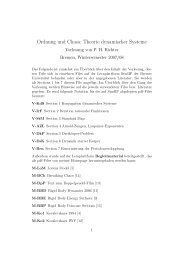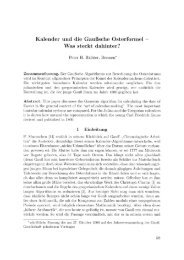The Beauty of the Gregorian Calendar
The Beauty of the Gregorian Calendar
The Beauty of the Gregorian Calendar
You also want an ePaper? Increase the reach of your titles
YUMPU automatically turns print PDFs into web optimized ePapers that Google loves.
- to get back in step with <strong>the</strong> moon, <strong>the</strong> epact is occasionally reset;<br />
- all this is done in an easily computable manner; <strong>the</strong> specific details may<br />
be adapted to improved astronomical data.<br />
Let us comment on <strong>the</strong>se principles in some depth. <strong>The</strong> fundamental<br />
decision was to adhere to <strong>the</strong> ancient tradition <strong>of</strong> a lunisolar calendar. Given<br />
that <strong>the</strong> Council <strong>of</strong> Nicaea (325 AD) had determined to celebrate Easter on<br />
<strong>the</strong> first Sunday after <strong>the</strong> first full moon in spring, this decision was <strong>of</strong> course<br />
never in doubt. But <strong>the</strong> custom to number days according to <strong>the</strong>ir position<br />
in both <strong>the</strong> solar and <strong>the</strong> lunar cycle, antecedes Christian traditions and<br />
goes back at least to <strong>the</strong> Babylonians. It may not be widely known, but our<br />
calendar counts days not only from 1 through 365 (or 366) as members <strong>of</strong> <strong>the</strong><br />
solar cycle, but also from 1 through 29 (or 30) in <strong>the</strong> lunar cycle. <strong>The</strong> epact<br />
E is related to this lunar counting; it is defined as <strong>the</strong> age <strong>of</strong> <strong>the</strong> moon on<br />
New Year’s day. <strong>The</strong> possible values <strong>of</strong> E are 0, 1, . . . , 29. E = 0 means new<br />
moon on New Year’s day; E > 0 means <strong>the</strong> last new moon was on December<br />
32 − E <strong>of</strong> <strong>the</strong> old year.<br />
<strong>The</strong> original Julian calendar, as decreed by Julius Cesar in 45 BC, dealt<br />
only with <strong>the</strong> solar cycle, and fixed <strong>the</strong> length <strong>of</strong> <strong>the</strong> year to<br />
YJ = [365, 4] = 1461<br />
4<br />
= 365.25. (10)<br />
In <strong>the</strong> aftermath <strong>of</strong> <strong>the</strong> Council <strong>of</strong> Nicaea, it was combined with <strong>the</strong> Metonic<br />
19-year cycle in order to account for <strong>the</strong> motion <strong>of</strong> <strong>the</strong> moon. This means<br />
<strong>the</strong> average number N <strong>of</strong> synodic months per year was fixed as<br />
NJ = [12, 2, 1, 2, 1, 1] = 235<br />
19<br />
= 12.368 421... . (11)<br />
In this scheme, <strong>the</strong> epact E turned out to increase by 11 days, from year to<br />
year, or to recede by 19 days. (At <strong>the</strong> end <strong>of</strong> <strong>the</strong> 19-year cycle, <strong>the</strong> recess was<br />
only 18; this special reset was called saltus lunae). <strong>The</strong>re were 19 possible<br />
values <strong>of</strong> E = 11(G − 1) mod 30, depending on <strong>the</strong> golden number G. To<br />
compute Easter, one had to know, in addition, <strong>the</strong> weekday <strong>of</strong> New Year, and<br />
whe<strong>the</strong>r <strong>the</strong> given year was a leap year. It is not difficult to check that Easter<br />
could fall on any day between March 22 and April 25, in a 19 · 7 · 4 = 532<br />
year cycle. <strong>The</strong> first day in spring was assumed to be March 21, hence <strong>the</strong><br />
earliest possible full moon could be on that day, and <strong>the</strong> first next Sunday on<br />
March 22. <strong>The</strong> latest possible full moon in spring, according to this scheme,<br />
could occur on April 18; hence Easter could not be later than April 25. This<br />
Alexandrian canon was to be preserved in <strong>the</strong> <strong>Gregorian</strong> calendar.<br />
7




